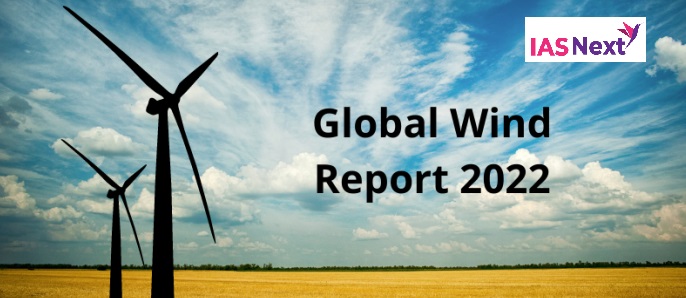CURRENT AFFAIRS
Get the most updated and recent current affair content on Padhaikaro.com
Global Wind Report 2022
- IAS NEXT, Lucknow
- 15, Apr 2022

Reference News:-
Released by: Global Wind Energy Council (GWEC).
What is GWEC? Established in 2005, it is the international trade association for the wind power industry, representing the united voice of the industry, globally.
Highlights of the Report:
- Wind energy installations every year across the world must quadruple from the 94 GW installed in 2021 within this decade to meet the global climate targets.
- Without the necessary amplification, restricting global warming over pre-industrial levels to 1.5 degrees Celsius — a target set by the Paris Agreement — and achieving Net Zero emissions by 2050 may become difficult.
- New offshore installations in 2022 are likely to decline to the 2019 / 2020 levels, primarily due to the reduction of installations in China.
- Market growth is expected to regain momentum from 2023, eventually passing the 30GW-mark in 2026.
- Offshore wind energy generation increases return on investment, along with reducing greenhouse gas emissions.
Challenges to growth:
- Inconsistent policy environments focused on short-term political aims.
- Badly designed markets which do not enable bankable renewable energy projects.
- Infrastructure and transmission bottlenecks.
- A lack of adequate industrial and trade policies related to renewable technologies Hostile political or misinformation campaigns.
Scope in India:
- More than 1.4 GW of wind was installed in 2021, exceeding the 1.1 GW of installations during the previous year.
- The Union Ministry of New and Renewable Energy (MNRE) has set a target of installing 5 GW of offshore capacity by 2022 and 30 GW by 2030. India is yet to develop its offshore wind energy facility.
- India can generate 127 GW of offshore wind energy with its 7,600 km of coastline.
Need of the hour:
- Governments to tackle issues such as planning barriers and grid connection challenges.
- To sustain and increase growth in wind-based generation capacity, policymakers are urged to streamline the procedures to grant permits, including land allocation and grid connection projects.
- Workforce planning for large-scale renewables deployment should be an early policy priority and investment in grids must treble from current levels through to 2030.
- Annual transition-related investment in the energy system must increase 2.7 times from the 2019 level, to $5.69 trillion a year till 2030.
- There is also a need for greater public-private co-operation to confront “the new geopolitics of the wind supply chain”.
- A stronger international regulatory framework is needed to address the increased competition for commodities and critical minerals.